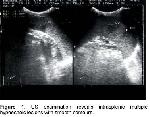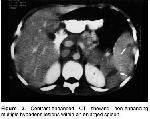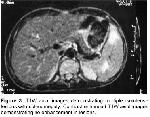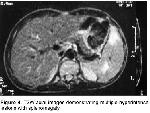 |
 |
| [ Ana Sayfa | Editörler | Danışma Kurulu | Dergi Hakkında | İçindekiler | Arşiv | Yayın Arama | Yazarlara Bilgi | E-Posta ] | |
| Fırat Tıp Dergisi | |||||||||
| 2005, Cilt 10, Sayı 2, Sayfa(lar) 080-082 | |||||||||
| [ Özet ] [ PDF ] [ Benzer Makaleler ] [ Yazara E-Posta ] [ Editöre E-Posta ] | |||||||||
| Multiple Splenic Abscesses in a Child as a Complication of Typhoid Fever | |||||||||
| Mürvet YÜKSEL1, Keramettin Uğur ÖZKAN2, Sevgi BAKARIŞ3 | |||||||||
| 1Kahramanmaraş Sütcüimam Üniversitesi Tıp Fakültesi Radyoloji Anabilim Dalı, KAHRAMANMARAŞ 2Çocuk Cerrahisi Anabilim Dalı, KAHRAMANMARAŞ 3Patoloji Anabilim Dalı, KAHRAMANMARAŞ |
|||||||||
| Keywords: Multiple splenic abscesses, typhoid fever, Çoğul dalak apsesi, tifo ateşi, | |||||||||
| Summary | |||||||||
Splenic abscess is a rare complication of typhoid fever in developing countries. Its clinical presentation is often non-specific. Here, we report a case of typhoid fever in a 12-year-old child with an unusual presentation; multiple splenic abscesses and review the literature for the complication of typhoid fever and the role of imaging findings in the diagnosis of splenic abscesses. ©2005, Fırat Üniversitesi, Tıp Fakültesi |
|||||||||
| Introduction | |||||||||
Splenic abscess is a very rare complication of typhoid fever. About 34 cases have been described since 1977 but only a few of them had multiple splenic abscesses. The clinical diagnosis of splenic abscess due to typhoid fever is difficult because of its rarity, insidious and nonspecific clinical presentation 1,2. In this report, we present a rare case of multiple splenic abscesses with nonspecific clinical symptoms caused by Typhi in a previously healthy child and review the literature for the complication of typhoid fever and the role of imaging findings in the diagnosis of splenic abscesses. |
|||||||||
| Case Presentation | |||||||||
12-year-old child living in rural area was admitted to our hospital with symptoms of a 2-week history of fever and abdominal pain. His past medical history was non-contributory. On physical examination, the patient was febrile to 39ºC The abdominal examination revealed generalized tenderness and minimal muscular defense. Laboratory tests demonstrated: hemoglobin, 12.0g/dl; white blood cells count of 5.100/mm3 47.6% neutrophils), platelet count 243.000. Serum urea, creatinin levels and urinary sediment analysis were normal. Blood cultures and serological tests were positive for S. Typhi. Urine and stool cultures were negative for S. Typhi. A sicklecell test was also negative. Thus ceftriaxone treatment was started to the patient because of positive blood culture of S. Typhi. Although an antibiotic regimen of ceftriaxone was given (100mg/kg/day for 10days), fever, abdominal pain and abdominal tenderness persisted in the patient. Because of the persistent characteristic of the symptoms, abdominal ultrasonographic (US) examination was requested to determine whether any complication of typhoid fever was present. An abdominal US (Figure 1).
Showed splenomegaly with multiple hypoechoic areas the biggest of which was 35mm in diameter. Then, abdominal computed tomography (CT) and magnetic resonance imaging (MRI) examinations were applied for differential diagnosis. At CT scan low density splenic lesions that were not enhanced by contrast media were determined (Figure 2).
MRI showed multiple lesions in spleen that were isointense on T1-weighted (Figure 3) and hyperintense on T2- weighted (Figure 4) images.
No contrast enhancement following the injection of gadolinium was observed (Figure 3). The diagnosis of splenic abscess of typhoid fever was made on the basis of the serologic tests, blood cultures that were positive for S. Typhi and the findings demonstrated in the imaging procedures. Splenectomy was preferred as the therapeutic approach since the multiple splenic abscesses were inappropriate for percutaneous drainage. The histopathological examination of the spleen showed a well circumscribed with a fibrous wall and accompanied by white pulp hyperplasia of the surrounding splenic tissue. The postoperative recovery was normal. |
|||||||||
| Discussion | |||||||||
Typhoid fever is usually characterized by fever, headache, and gastrointestinal symptoms. Its complications occur mainly in untreated patients or when treatment is delayed. These complications can be seen as intestinal bleeding, intestinal perforation, pneumonia, acute cholecystitis, hepatitis, osteomyelitis, intraabdominal abscess, urinary tract infection, and meningitis 3. In our patient, the clinical presentation was nonspecific abdominal pain and fever. Furthermore a very rare complication, multiple splenic abscesses, was observed. Its low incidence is due to of the phagocytic activity of the reticuloendothelial system and leukocytes 2. Splenic abscesses frequently develops in the third or fourth weeks of infection 3. A few cases with multiple splenic abscesses caused by S. Typhi were described in the literature. Allal et al reported 400 patients with S. Typhi and found 8 (2%) splenic abscess cases of which only one had multiple splenic abscesses with two abscess areas (0.25%) 2. Torres et al documented 10 cases of S. Typhi with splenic abscesses. All their patients had large solitary abscesses 4. In our case, we observed multiple abscesses in four different areas in the spleen. Predisposing factors for splenic abscess are usually impaired host resistance, subacute bacterial endocarditis, trauma, diabetes mellitus, urinary tract infection, skin sepsis, respiratory tract infection, and intravenous drug abuse 2. Sickle cell disease is also present in about one-third of patients with splenic abscesses 5. Multiple splenic abscesses are found in immunodeficient patients who have poor prognosis 1. This case was interesting since the patient had multiple splenic abscesses even though none of these predisposing factors was found. Previously reported US findings of splenic abscess include hypoechoic mass with or without internal echogenicity due to debris, septations and layering. On CT evaluation, they are homogeneous low density lesions with occassional rim enhancement 1,2. Intravenous administration of contrast medium may sometimes improve the definition of the lesions 2. In splenic abscess, CT evaluation is important because it is more specific than US evaluation in delineating gas bubbles which is diagnostic for splenic abscess, in visualizing the peripheral contrast enhancement and in providing clear demonstration of the location of the abscesses. 2,6. US findings we observed in our patient were splenomegaly and multiple hypoechoic areas at central and peripheral locations in the spleen with different size of which the greatest was 35mm. CT findings with contrast were multiple hypodense lesions in the spleen without contrast enhancement. No intrasplenic gas was found either. To our knowledge there has been no case in which MRI findings of S. typhi splenic abscess have been reported that is why we performed MRI evaluation. MRI may reveal some clues in the diagnosis by defining the extent and internal structure of splenic abscess because of its greater tissue resolution. In our patient, MRI examination showed T1- weighted images with isointense, T2-weighted images with hyperintense multiple lesions and no contrast enhancement was detected following the injection of gadolinium. The findings demonstrated in these imaging procedures were helpful for the early diagnosis of splenic abscess together with clinical presentations, serologic test or blood cultures which were positive for Salmonella typhi. The treatment of splenic abscesses was until recently splenectomy with antibiotherapy. The actual trends are more conservative because the immunologic role of the spleen has been better understood over the last year 7. Percutaneous drainage can be an alternative treatment for splenic abscesses and might avoid splenectomy 8 but splenectomy is the preferred treatment of choice in multiple splenic abscesses 1. In our case, splenectomy was preferred for treatment because of the resistance to the medical therapy for 10 days and multiplicty characteristic of splenic abscesses that were not suitable for percutaneous catheter drainage. In conclusion, S.typhi multiple splenic abscess is a very rare and fatal complication of typhoid fever which must be borne in mind in circumstances that medical therapy is not effective. Non-invasive imaging modalities including US, CT and sometimes MRI are useful for early diagnosis of splenic abscess. |
|||||||||
| References | |||||||||
1) Ng KK, Lee TY, Wan YL, et al. Splenic abscess: diagnosis and management. Hepatogastroenterology 2002; 49: 567-571.
2) Allal R, Kastler B, Gangi A, et al. Splenic abscesses in typhoid fever:US and CT studies. J Comput Assist Tomogr 1993; 17: 90- 93.
3) Lambotte O, Debord T, Castagne C, Roue R. Unusual presentation of typhoid fever: cutaneous vasculitis, pancreatitis, and splenic abscess. J Infect 2001; 42: 161-162.
4) Torres JR, Gotuzzo E, Isturiz R, et al. Salmonellal splenic abscess in the antibiotic era: a Latin American perspective. Clin Infect Dis 1994; 19: 871-875.
5) Jaussaud R, Brasme L, Vernet-Garnier V, Deville JF. Splenic abscess complicating salmonella typhi infection. Eur J Clin Microbiol Infect Dis 2000; 19: 399-400.
6) Taşar M, Ugurel MS, Kocaoglu M, Saglam M, Somuncu I. Computed tomography-guided percutaneous drainage of splenic abscesses. Clin Imaging 2004; 28: 44-48.
|
|||||||||
| [ Başa Dön ] [ Özet ] [ PDF ] [ Benzer Makaleler ] [ Yazara E-Posta ] [ Editöre E-Posta ] | |||||||||
| [ Ana Sayfa | Editörler | Danışma Kurulu | Dergi Hakkında | İçindekiler | Arşiv | Yayın Arama | Yazarlara Bilgi | E-Posta ] |



